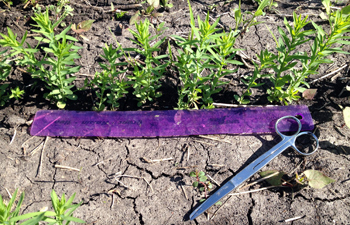The People Behind the Research
A Conversation with Dr. Terence McGonigle
Brandon University
Ìý
Activity A.7: Well-established commercial organic farming: Effect of rate of composted manure application on soil mineral nutrients, yield, and crop nutrient uptake
 |
Industry Partner: Howpark FarmÌýÌýÌýÌýÌýÌýÌýÌý Ìý Ìý Ìý ÌýÌý Ìý Ìý Ìý Ìý Ìý ÌýÌý Ìý Ìý ÌýÌý ÌýÌýÌýÌýÌýÌýÌýÌýÌýÌýÌýÌýÌýÌýÌýÌýÌýÌýÌý |
Can you tell us a bit about yourself?
From 1987 to 1997, I was employed on various agricultural research projects as a scientist in the Ontario Agricultural College of Guelph University. I was appointed to the faculty at Brandon University in 2005, and I have been active partly in agricultural research in Manitoba since that time.
Can you briefly explain your Research Activity in Organic Science Cluster II (OSCII)?
The study is investigating the sources of nitrogen and phosphorus for crops in a commercial organic operation, which of course has no synthetic fertilizer inputs permitted. Instead, the application of composted manure and the inclusion of legumes in the rotation are potential sources for the mineral nutrients required by crops.
The farming system that the study is based upon works well, and this study aims to identify the essential features that bring about this success. The study farm uses a seven-year rotation, which has three years of alfalfa, followed by flax, then oats, followed by a red clover green manure, and concludes with fall rye or wheat.Ìý Manure compost prepared from cattle raised on the farm is added in the fall prior to the flax, oats, clover, and lastly either wheat or rye, before the sowing of alfalfa to renew the cycle.
I wanted to look more closely at whether it is the manure inputs or the legumes in the rotation that is critical for the inputs of nitrogen and other macronutrients needed to sustain yields at an economic level within the organic market. Head-to-head comparisons of conventional versus organic production is not possible in this on-farm study, as parallel production is prohibited within a certified organic commercial operation.
The OSCII field experiment began in March 2014 and uses replicated and randomized treatments to examine the impacts of four levels of manure application, including control plots that receive no manure. In the fall of 2013, the season before our plots were established, the field being used was coming out of the third year of alfalfa in the crop rotation. Over the course of the experiment, we will be looking at many aspects of nutrient availability and uptake, so data to be collected includes the levels of nitrogen and phosphorus in crop plant shoots, soil mineral nitrogen, and available soil phosphorus. We will continue to collect data throughout the project, which will allow the impact of manure applications and plow downs to be followed through time.
What brought you to this research, and what excites you the most about this project?
Interaction with the organic farming community raised the important questions about the underlying mechanisms at work in organic production. The hope that the data collected will offer insight to guide other producers considering organic production is the part of the project that is most exciting.
How has this Research Activity expanded your traditional research program?
Moving from conventional production into organic agriculture has expanded my research activities. To give an example of my typical research, my most recent publication (McGonigle and Grant, in press, Can J. Plant Science) investigated root uptake of potassium and calcium in relation to time and soil depth, and provided recommendations for fertilizer banding practices.Ìý What do I find challenging about working in organic systems? The prohibition of parallel production on a commercial farm, which can make research comparisons difficult.
Where is your project taking place? Are there factors that make this location especially suitable for your work?
The research takes place on Howpark Farm, a commercially successful organic farm south of Brandon. Conducting the work on the commercial farm makes the project especially important, because the limitations imposed on the production system are the same as those faced by other farmers.
How do you envision that your research will help organic producers in Canada?
Identification of the sources of nitrogen and phosphorus for crops will allow other growers to consider incorporating essential features of the successful farming system on the study farm to their own production systems. From this research, we will hopefully find out if the essential features of the successful system are the legumes, the manure, or both.
How have the organic community and your industry partners helped to shape your research?
Input from the cooperating producer has been fantastic to encourage the work and design the study.
Are there graduate students, undergraduate students, or postdoctoral fellows involved in this research?Ìý
Students are employed for the field research, and a former student is employed as a technician to undertake the laboratory analyses of the samples collected. These activities contribute to the training and human resources development of young scientists in Canada with skills in experiment design and sample analysis.
Ìý
For more information on Terence McGonigle’s work in OSCII, please visit . A print-friendly version of this article is available [PDF - 410 kB].
The (OSCII) project described in this article is supported by the of 's and . OSCII and this article are collaborative initiatives of the at and the .

